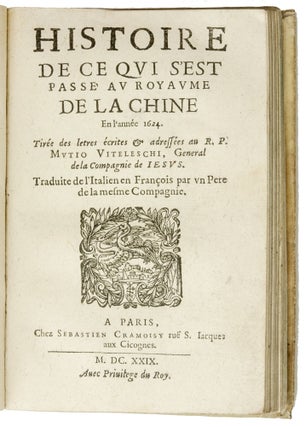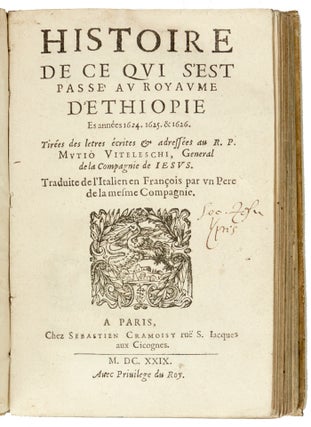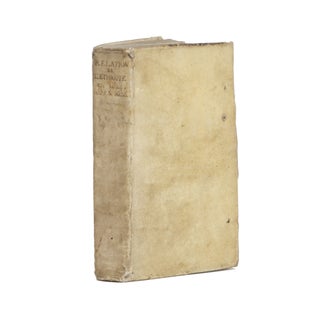Histoire de ce qui s’est passé au royaume de Tibet.
940 ff., 104 pp. [Bound with:] [CHINA] / KIRWITZER,Wenceslaus Pantaleon / DARDE, Jean / MACHAUKT, J.-B. (trans.) Histoire de ce qui s’est passé au royaume de la Chine en l’année 1624. Paris, Sebastian Cramoisy, 1629. (2) ff., 102, 1 integral blank. [And with:] [ETHIOPIA] / MENDEZ, Alfonso / PAEZ, Gaspar / MACHAULT, J.-B. (trans.) Histoire de ce qui s’est passé au royaume d’Ethiopie es années 1624, 1625, 1626. Paris, Sebastian Cramoisy, 1629. 8vo., (8) ff., 252 (ie 262), 1 blank. Bound in contemporary yapp-edged stiff vellum, with title neatly inked on spine. 19th century ex libris ticket of “M. le Comte de Preston” [ie the Count of Preston, Lancashire, UK] on front end pastedown; contemporary ownership inscription of the 18th century philologist and historian Jean-Noël Paquot on front endpaper. Ownership inscription of the Society of Jesus, Yprès, on title page of first work. Some inconsequential finger soiling on title and a few quires even toned in middle title, but generally an unsophisticated fresh copy, superb. Exceptional collection of three important Jesuit letters, in entirely original condition. All were published by the Jesuits’ official French publisher, Sebastian Cramoisy, and all were printed the same year. One can imagine an interested reader assembling the three titles in Cramoisy’s bookshop in or near the time of publication. 1) Rare first French edition of Andrade’s second (and final) letter on his experiences in Tibet. Antonio de Andrade (1580-1634) was the first European to set foot in Tibet, as we must assume that Marco Polo and Odoric of Podernone’s reports were second-hand. Andrade’s second letter contains an enormous amount of detail on the customs of Tibet, particularly those of the lamas whom Andrade spent the most time with. His observations are quoted at length by Lach and Van Kley (pp. 1780-2), ranging from ceremonial fasting in which the lamas speak only through clenched teeth, to the donning of masks to prevent evil spirits from entering the lamas during a ritual exorcism. “To protect babies from demons or evil spirits Tibetans often give them despicable names such as Dog, Mouse, or Cold Wind,” a custom described for the first time here on pp 33-4. Father Andrade seems to have enjoyed a close relationship with his hosts: on one occasion (pp. 15-16) he expresses his astonishment at seeing lamas dancing with one another (“nos Ecclesiastiques estoient si grave & si retenus…”). He is answered by an older, wiser lama who tells him not be so surprised: the dancing lamas represent angels, and in scenes of the Christian Nativity are not angels also seen to be singing and playing musical instruments? Andrade succeeded in establishing a Jesuit mission in Tibet in 1625, which flourished only until 1630, when a hostile new ruler took power. “From this brief Jesuit mission, however, and from Grueber and D’Orville’s later visit to Lhasa, came Europe’s first significant glimpse into the land on the roof of the world…the image of Tibet presented to seventeenth-century European readers by Andrade, Godinho, and Grueber, while incomplete, was perceptively and sympathetically drawn and for the most part accurate.” – Lach & van Kley, p. 1783. Andrade’s second letter was first published in 1628 and quickly enjoyed translations in many European vernaculars, as the exciting discovery of a new kingdom ‘on the roof of the world’ continued to enthrall European readers. Tibet was still largely unknown to Europeans at the dawn of the seventeenth century. The first account of that country by a modern European to appear in print was Andrade’s letter of 1624, published at Lisbon in 1626. As he relates in the present work, having been congratulated by his superiors on his successful first mission, he was ordered to return to Tibet a year later, setting out in June of 1625. By August he had reached the Himalayan kingdom, where he was effusively welcomed back by the ruler of Guge. 2) Kirwitzer’s letter on China is the rare first French edition of this annual report, considered by Lach an important source for the politically transitional period between the death of the Wan-li emperor in 1620 and his young successor (AsiaIII.1.403). “Aside from reporting on the progress of the Jesuits, he comments on the weakness of the Ming ruler, who has no interest in recovering the Liao-tung from the Manchus since it had produced no literati of consequence during the three hundred years of its rule by China.” -- Asia III.1.376. The section on Peking contains material on the astronomical activity of Adam Schall von Bell (p. 45 ff.), and there is a mention of the King of Korea in connexion with the Manchurian invasion (p. 8); the Koreans had joined in the defense of the Ming (see Lach III.1.374-5). The Bohemian Kirwitzer (1588-1625) died in Macau or Kyoto, shortly after the present work was composed. 3) Alphonso Mendez and Gaspar Paez’s letters from Ethiopia concern the attempted reconciliation of the Catholic faith with Ethiopian Orthodox Christianity between 1624-6. Alphonso Mendez had been appointed Patriarch of Ethiopia in 1624 and arrived in the country in 1625, immediately instituting strict regulations against Orthodox practices. Priests were forced to become reordained, Christians rebaptized, and churches reconsacrated; above all the Pope was forced to be recognized as the highest terrestrial authority (Ethiopia And the Missions: Historical And Anthropological Insights, pp. 53-5). Such measures, described in the present account as highly successful, inevitably proved extremely unpopular; Mendez’s successor, Gaspar Paez, describes in the second letter the first hints of a broader rebellion which would consume the empire by the 1630s. Provenance information for Jean-Noel Pacquot: https://en.wikipedia.org/wiki/Jean-No%C3%ABl_Paquot *Cf also Lach & van Kley, Asia in the Making of Europe Vol III Book 4, pp. 1773-83; The Beijing Center for Chinese Studies, “How the West Learned of China Collection”; and Verena Böll, Ethiopia And the Missions: Historical And Anthropological Insights (2005). Locations and references: Andrade: De Backer Sommervogel II.1824; Streit V, 310; Cordier 2901. OCLC: NYPL, UCLA, Catholic University of America, Yale. Kirwitzer: De Backer Sommervogel II.1824; Cordier 815; Chadenat 4896. OCLC: UCLA, Catholic University of America, Bell, LC, Brandeis, Cornell, Yale. Mendez & Paez: De Backer Sommervogel V, 258; Carayon 906; unknown to Chadenat, Brunet and Barbier. OCLC: LC, NYPL, Catholic University of America, Peabody, Bell..
Price: $12,500.00




